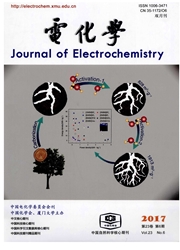

 中文摘要:
中文摘要:
选择甲基磺酰氟(CH3SO2F)电化氟化制备CF3SO2F过程为研究系统,研究了电化氟化过程操作电压和反应时间的关系、操作条件对氟化产物组成的影响规律以及镍(Ni)电极在电化氟化过程的变化情况.实验结果表明,Simons电化学氟化过程主要由3个步骤组成:F-在阳极发生电化学氧化反应生成Fa该步骤是Simons电化学氟化过程的控制步骤;在Ni电极上生成的F与Ni或NiF2反应生成高价NiFn(n≥3),NiFa为Simons电化学氟化过程的氟化剂;NiFa可以在电极/电解液界面与有机物发生氟化反应生成氟化产物,也可以发生分解反应生成游离F2,NiFa与有机物发生氟化反应的机理与用CoF3等为氟化剂氟化有机物的机理相同,但NiFa的反应活性比CoF3高,且在实验条件下极不稳定.
 英文摘要:
英文摘要:
The characteristics and mechanism for the Simons electrochemical fluorination processes were investigated during the electrochemical fluorination of CH3SO2F to CF3SO2F. The results showed that the reaction mechanism for the electrochemical fluorination of organic compounds to organic fluorides was the same as that of chemical fluorination processes using fluorinating agents such as CoF3. The electrochemical fluorination in anhydrous HF was a heterogeneous process, and nickel fluorides on the surface of the nickel anode played the role of a mediator in the Simons process to transfer oxidation potential fi-om the anode to the substrate and fluorine from HF to the organic substance. Nickel fluorides were formed electrochemically on the surface of the nickel anode by oxidation of Ni in anhydrous HF to a high valence (with the oxidation stage more than +2) nickel fluorides. The fluorinat ing agents in electrochemical fluorination processes were NiFn(n≥3 ), high valences of nickel produced at the anode, which is much more reactivie than CoF3 and instable under the experimental conditions, The decomposion of NiF, to F2 would take place, and NiFo could also react with organic fluoride. Because F2 is a strong fluorinating agent, NiF, could be decomposed into low molecular weight organic compounds fluorinated products, leading to low current efficiency in process yield and by-products. Therefore, an effective method to improve the process is by increasing the molar ration of organic matter to NiFa on the anode/electrolyte interface.
 同期刊论文项目
同期刊论文项目
 同项目期刊论文
同项目期刊论文
 期刊信息
期刊信息
